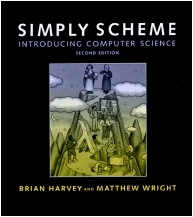
| Brian
Harvey University of California, Berkeley |
| Matthew
Wright University of California, Santa Barbara |
| Download PDF version |
| Back to Table of Contents |
| BACK chapter thread NEXT |
| MIT Press web page for Simply Scheme |

|
|
The idea of this project is to invent a procedure poker-value
that works like this:
> (poker-value '(h4 s4 c6 s6 c4)) (FULL HOUSE - FOURS OVER SIXES) > (poker-value '(h7 s3 c5 c4 d6)) (SEVEN-HIGH STRAIGHT) > (poker-value '(dq d10 dj da dk)) (ROYAL FLUSH - DIAMONDS) > (poker-value '(da d6 d3 c9 h6)) (PAIR OF SIXES)
As you can see, we are representing cards and hands just as in the Bridge project, except that poker hands have only five cards.[1]
Here are the various kinds of poker hands, in decreasing order of value:
| • | Royal flush: ten, jack, queen, king, and ace, all of the same suit |
|---|
| • | Straight flush: five cards of sequential rank, all of the same suit |
|---|
| • | Four of a kind: four cards of the same rank |
|---|
| • | Full house: three cards of the same rank, and two of a second rank |
|---|
| • | Flush: five cards of the same suit, not sequential rank |
|---|
| • | Straight: five cards of sequential rank, not all of the same suit |
|---|
| • | Three of a kind: three cards of the same rank, no other matches |
|---|
| • | Two pair: two pairs of cards, of two different ranks |
|---|
| • | Pair: two cards of the same rank, no other matches |
|---|
| • | Nothing: none of the above |
|---|
An ace can be the lowest card of a straight (ace, 2, 3, 4, 5) or the highest card of a straight (ten, jack, queen, king, ace), but a straight can't "wrap around"; a hand with queen, king, ace, 2, 3 would be worthless (unless it's a flush).
Notice that most of the hand categories are either entirely about the ranks of the cards (pairs, straight, full house, etc.) or entirely about the suits (flush). It's a good idea to begin your program by separating the rank information and the suit information. To check for a straight flush or royal flush, you'll have to consider both kinds of information.
In what form do you want the suit information? Really, all you need is a true or false value indicating whether or not the hand is a flush, because there aren't any poker categories like "three of one suit and two of another."
What about ranks? There are two kinds of hand categories involving ranks: the ones about equal ranks (pairs, full house) and the ones about sequential ranks (straight). You might therefore want the rank information in two forms. A sentence containing all of the ranks in the hand, in sorted order, will make it easier to find a straight. (You still have to be careful about aces.)
For the equal-rank categories, what you want is some data structure that will let you ask questions like "are there three cards of the same rank in this hand?" We ended up using a representation like this:
> (compute-ranks '(q 3 4 3 4)) (ONE Q TWO 3 TWO 4)
One slightly tricky aspect of this solution is that we spelled
out the numbers of cards, one to four, instead of using the more
obvious (1 Q 2 3 2 4). The reason, as you can probably tell just by
looking at the latter version, is that it would lead to confusion between
the names of the ranks, most of which are digits, and the numbers of
occurrences, which are also digits. More specifically, by spelling out the
numbers of occurrences, we can use member? to ask easily if there is
a three-of-a-kind rank in the hand.
You may find it easier to begin by writing a version that returns only the
name of a category, such as three of a kind, and only after you get
that to work, revise it to give more specific results such as three
sixes.
In some versions of poker, each player gets seven cards and can choose any five of the seven to make a hand. How would it change your program if the argument were a sentence of seven cards? (For example, in five-card poker there is only one possible category for a hand, but in seven-card you have to pick the best category that can be made from your cards.) Fix your program so that it works for both five-card and seven-card hands.
Another possible modification to the program is to allow for playing with "wild" cards. If you play with "threes wild," it means that if there is a three in your hand you're allowed to pretend it's whatever card you like. For this modification, your program will require a second argument indicating which cards are wild. (When you play with wild cards, there's the possibility of having five of a kind. This beats a straight flush.)
Brian Harvey,
bh@cs.berkeley.edu